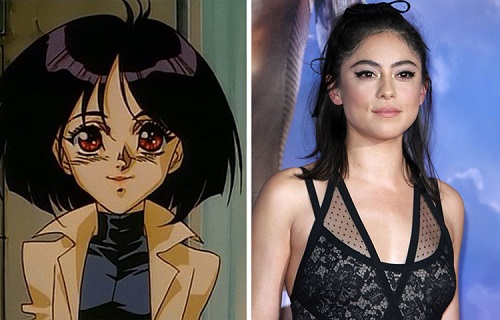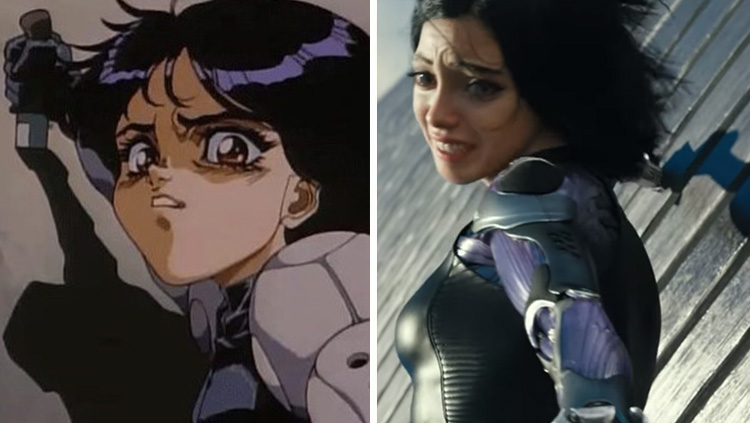Hollywood and anime have a complicated relationship. As the current period indicates, it is a wellspring from which moneyed interests cannot help but draw inspiration. The allure of an established IP with a built-in consumer base is too commercially appealing to ignore, especially as anime becomes increasingly popular. Whether speaking of animated television shows like The New Adventures of Speed Racer (1993) or live-action adaptations on streaming platforms like Netflix’s Death Note (2017), U.S. involvement with well-known franchises an ocean away has certainly not been limited to the big screen.
But even in such an international consumer culture of media, Hollywood as a social and financial institution remains an influential entity both within the United States and abroad. While the box office functions as a quick litmus test for approval of a specific film from the general public, awards and recognition doled out to actors and filmmakers help industry establishments like the Academy act as de facto gatekeepers of filmmaking taste. What’s more, as commercial products of a capitalist system, the creative decisions employed during any given adaptation, e.g. casting based on race or even gender, give insight as to what producers, consultants, and possibly also filmmakers themselves gauge to be in demand by paying customers.
The realm of anime still proves to be a difficult one to maneuver for Hollywood, particularly in more recent years as the proliferation of social media has allowed previously underrepresented voices to express their grievances and potentially galvanize audiences. Hollywood, no stranger to adaptations in general (whether from literature or foreign films), will typically whitewash prominent roles in order to appeal to hegemonic expectations of Anglo-America. While, unfortunately, these often latent expectations still persist, with anime and audience members now connected to the internet it is not so simple a matter. Concerns of fidelity to source material are much more pronounced, be it based mostly on a desire for adherence to an original work or stemming from concerns of cultural appropriation.
An example of both can be found in the now-infamous Dragonball Evolution (2009). With a modest budget of around $30 million, in addition to its somewhat lackluster special effects the film was criticized for casting a white actor, Justin Chatwin, as protagonist Goku. On the one hand, this fascinatingly is not even a lackadaisical attempt at masking the national origins of the original manga by Akira Toriyama: the character in the movie is named Goku, mimicking the source material, whereas in aforementioned Death Note the main character Light Yagami, played by Nat Wolff, is given a quick alteration to Light Turner. On the other, it is testament to Hollywood’s true colors: rather than cast a Japanese actor, or even an Asian one, studio heads decided that they would rather a white man appear onscreen with a noticeably nonwhite name than risk asking audiences to empathize with a nonwhite face attached to it.

Narrative explanations to excuse whitewashing are fraught with perilous contradiction as well. A fan of Dragon Ball could accurately state that while the real-world origins of Goku as a fictitious character are Japanese (in this case, based also on Chinese culture), in the story he is revealed to be of extraterrestrial origin and therefore neither Asian nor white. Of course, one can only imagine the reaction to a nonwhite Clark Kent, as of course Superman also does not hail from planet Earth, but such double standards are perhaps for another article! The point here being that technicalities are not a foolproof shield against whitewashing or concerns thereof: Ghost in the Shell (2017) attempts to justify the casting of Scarlett Johansson as the Major based on its futuristic premise that individuals are able to consciously inhabit other bodies using technology—and therefore, presumably, change their outward appearance of race (though such containers are inherently problematic). On top of displeasing fans who may have wished for a more authentic representation of an established character, Rupert Sanders’ version of Ghost in the Shell ends up unintentionally resembling Jordan Peele’s horror debut Get Out (2017). The body-switching plot of the latter was praised for its bold thematic confrontation of the underlying racism that still pervades American politics (Bakare).
These issues, of course, also bring up a fact of which the layperson may not be aware: anime is not necessarily limited to telling Japanese stories centered on Japanese individuals or Japanese history. Though they are Japanese produced, anime and manga run the gamut of human experience, and creative authors and directors have depicted all kinds of fantastic worlds across dimensions of time and space. For a multitude of reasons, an anime may feature non-Japanese nationalities, be it due to genre, setting, or ethnicity in general being underemphasized with nondescript casts (the term mukokuseki describes some instances of this occurrence).
For these reasons and still more, conventional wisdom among many of those describable as anime enthusiasts, in some form or another, has long been that Americanized adaptations simply do not turn out well artistically or commercially. While Dragonball Evolution and Death Note garnered 20% and 24% audience approval rating from popular online review aggregator Rotten Tomatoes respectively, Alita: Battle Angel (2019) by Robert Rodriguez boasts a 92% audience score (as of this writing). Discrepancies between the user-submitted aggregate and the harsher feedback from critics could, perhaps, be partially attributed to the latter not knowing the source material, or otherwise not being calibrated to certain filmmaking sensibilities. It could also be due to critics possessing a more discerning gaze than the average viewer in various ways, and a lack of familiarity with an original work can further aid in the kind of clinical detachment endemic to a profession. Regardless, why might this adaptation of a manga-turned-anime have been received differently by fans or the public at large?
For starters, Yukito Kishiro, author of the original manga (titled Gunnm and localized as Battle Angel Alita in English), gave the film produced by James Cameron nothing but positive praise to the press. When asked if Rodriguez’s film captured the emotion of his work, he agreed wholeheartedly, stating “Maybe even better than the original” (“Passport”). Gestures like this make it permissible, or even desirable, for fans of Kishiro to be accepting of an adaptation that has been given an official seal of approval. There is also the fact that the highly stratified dystopia depicted in Gunnm—brilliantly symbolized by the wealthy inhabitants of Zalem literally floating above the poor living in Iron City—resonates with many American viewers in an era of significant economic inequality and other ills associated with late-stage capitalism.
The setting and genre classification of Gunnm also gives it some leeway with regard to racial portrayals of characters onscreen. The cyberpunk world is set centuries in the future, where our current delineation of nations is irrelevant, and the cosmopolitan city of Zalem is populated with people from all over the world. This happened to work favorably for the whitewashing tendencies of mainstream American cinema: casting Christoph Waltz as Dr. Ido was strategic, as Waltz actually bears some resemblance to his character’s manga counterpart. In this specific instance, adherence to the original work also provided opportunity for a more diverse cast in general, which lead to the (perhaps otherwise unlikely) casting of Mahershala Ali as antagonist Vector. Lana Condor, who boasts Vietnamese heritage, plays the minor role of Koyomi, a character with an ostensibly Japanese name; this can be viewed as a nod to the real-world heritage and narrative of the original work (the name), as well as the overall intended multiculturalism of the series and film (an Asian face among the many ethnicities represented).
Leading lady Rosa Salazar as Alita underscores the pronounced Latina presence in promotional material and the film itself. Supporting roles by Eiza González Reyna and Michelle Rodriguez furthered this connotation. Robert Rodriguez, known for Americanizing Mexploitation filmmaking via films like El Mariachi (1992), contributes to the Latino pedigree; so too does Mexican filmmaker Guillermo Del Toro, who is said to have initially brought Gunnm to the attention of producer James Cameron (Carroll). Accordingly, those involved in the conception, production, and reception of Alita can make a somewhat justifiable claim that Hollywood is moving toward greater levels of inclusion. By asking moviegoers to empathize with a young Hispanic woman, rather than an Anglo male (or even female), in a sci-fi setting, Alita gained some much-needed ground in the struggle for diversity through meaningful portrayals of all kinds of individual experiences.

The overall achievement of Alita: Battle Angel represents a template for success to potentially be replicated by Tinseltown with other properties. It also presents us with provocative questions: Why, for instance, is there such little Japanese, or even Asian, representation in a film whose original author is from Japan? True enough the casting is more reflective of present-day America, the target audience of the film, than much of American cinema: But as a growing demographic in the U.S., are Hispanic names and faces somehow decidedly more palatable, less of an Other, to producers or even audiences than Asian counterparts? Does this discount Japanese-Americans? Furthermore, Latinos can be of Asian, African, and Native American descent: Does this demonstrate that, as has been the case in the past, lighter-skinned Latinos with noticeable European heritage are favored for leading roles in big-budget productions?
With a Latina lead, manga source material, and mechanical brutality reminiscent of The Terminator movies, Alita in hindsight seems a measured dose of exotic and familiar, foreign yet still American, ideally suited for the globally minded, nostalgia-fueled consumer culture of the United States today. With adaptations likely to remain on the rise, let us hope they take a page or two out of the Alita: Battle Angel playbook. As we continue to wrestle with the complex issues of appropriation and representation in media, may it be noted that, at last, it has been proven possible that an Americanized take on anime and manga can be respectful to source material while being reflective of its own society.
© 2020 (text)
Works Cited
“Alita: Battle Angel.” Rotten Tomatoes, https://www.rottentomatoes.com/m/alita_battle_angel. Accessed 10 Apr. 2020.
Bakare, Lanre. “Get Out: The Film That Dares to Reveal the Horror of Liberal Racism in America.” The Guardian, 28 Feb. 2017, https://www.theguardian.com/film/2017/feb/28/get-out-box-office-jordan-peele. Accessed 8 Apr. 2020.
Carroll, Larry. “‘Avatar’ Producer Says ‘Battle Angel Alita’ Has a New Name, Will Follow ‘Avatar 2’.” MTV, 18 Feb. 2010, http://www.mtv.com/news/2596073/avatar-producer-says-battle-angel-alita-has-a-new-name-will-follow-avatar-2/. Accessed 8 Apr. 2020.
“Death Note.” Rotten Tomatoes, https://www.rottentomatoes.com/m/death_note_2017. Accessed 10 Apr. 2020.
“Dragonball Evolution.” Rotten Tomatoes, https://www.rottentomatoes.com/m/dragonball. Accessed 10 Apr. 2020.
Kishiro, Yukito. “Passport to Iron City with Battle Angel Alita Mangaka Yukito Kishiro.” Interview with Zac Bertschy, Anime News Network, 4 Feb. 2019, https://www.animenewsnetwork.com/feature/2019-02-04/passport-to-iron-city-with-battle-angel-alita-mangaka-yukito-kishiro/.142987. Accessed 8 Apr. 2020.







